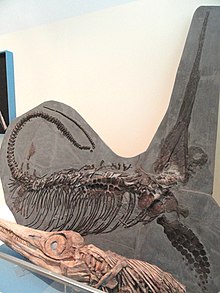Leptonectidae
| Leptonectidae | ||||||||||||
|---|---|---|---|---|---|---|---|---|---|---|---|---|

Eurhinosaurus longirostris in the Stuttgart State Museum for Natural History |
||||||||||||
| Temporal occurrence | ||||||||||||
| Triassic ( Rhaetian ) to Lower Jurassic ( Toarcian ) | ||||||||||||
| 208.5 to 174.1 million years | ||||||||||||
| Locations | ||||||||||||
| Systematics | ||||||||||||
|
||||||||||||
| Scientific name | ||||||||||||
| Leptonectidae | ||||||||||||
| Maisch , 1999 | ||||||||||||
| Genera | ||||||||||||
|
||||||||||||
The Leptonectidae represent a family of the Neoichthyosauria . They appear for the first time in the Rhaetium ( Upper Triassic ) of England and are recorded for the last time in the Toarcian ( Lower Jurassic ) of southern Germany. These are medium-sized, up to 6 meters long ichthyosaurs from Europe . The genera Leptonectes , Excalibosaurus and Eurhinosaurus belong to this family . The Leptonectidae family was established by Maisch in 1998.
features
This monophyletic group shares distinctive features. So their members have longipinnate fins with 3 to 4 primary finger rays. The upper and lower jaws are greatly elongated and narrow. Some members of this family have pronounced overbites. The eye sockets are extremely large and the cheek region is reduced. The temporal windows are small, the teeth are small, pointed, narrow and have a smooth surface. Motani lists the following characteristics as diagnostic for the Leptonectidae:
- Cheek aligned posterolaterally, narrow in lateral view
- extremely slim snout
- small teeth (in relation to the skull)
- The tibia and fibula are separate
Maisch defines the Leptonectidae in this way:
- longipinnate, elongated, narrow fins
- four, of the three fingers are very long and narrow
- Tendency to overbite
- large eye sockets and a short postorbital skull segment
- reduced temproal window (half the size of the eye socket)
- Narrow and pointed teeth, without sculpting
Paleoecology
It can be assumed that representatives of the Leptonectidae are not an offshore form of the ichthyosaurs. Their overall less pronounced kink of the tail, the ratio of the fore to the hind fins and the less rigid physique compared to higher ichthyosaurs, which allowed a more agile and flexible movement, indicate a more coastal lifestyle.
Taxonomy
The following taxonomy is taken from Maisch (2010).
- Minorder Parvipelvia
- Family Hudsonelpidiidae
- Macgowaniidae family
- Suborder Neoichthyosauria
- Family Temnodontosauridae
- Family Leptonectidae
- Family Suevoleviathanidae
- Infraorder Thunnosauria
Phylogeny
The Leptonectidae are closely related to the Temnodontidae and the Suevoleviathanidae . The following cladogram shows the relationships within the Leptonectidae and their sister groups .
| Parvipelvia |
|
|||||||||||||||||||||||||||||||||||||||
|
|
Geographical distribution
Species of the family Leptonectidae are found in various regions of Europe. The distribution ranges from southern England , through Germany , Luxembourg , Austria , Belgium and France to northern Switzerland .
Stratigraphy and time horizon
The Leptonectidae family occurs for the first time with the genus Leptonectes in the preplanorbis layers of the Rhaetium ( Upper Triassic ) of southern England . The most recent fossils of this family include the genus Eurhinosaurus and were in the bifrons / variabilis -Grenzzone the Middle Toarcian of Switzerland demonstrated.
Sources and References
literature
- Christopher McGowan, Ryosuke Motani: Ichthyopterygia In: Handbook of Paleoherpetology, Part 8 , Verlag Dr. Friedrich Pfeil, 2003.
Individual evidence
- ↑ a b c d M. W. Maisch: A new ichthyosaur genus from the Posidonia Shale (Lower Toarcian, Jurassic) of Holzmaden, SW-Germany with comments on the phylogeny of post-Triassic ichthyosaurs. In: Neues Jahrbuch für Geologie und Paläontologie, Abhandlungen 209, 1998, pp. 47–78
- ↑ a b c M. W. Maisch: Phylogeny, systematics, and origin of the Ichthyosauria - the state of the art. In: Palaeodiversity 3, 2010, pp. 151-214.
- ↑ a b M. W. Maisch, AT Matzke: The Ichthyosauria. In: Stuttgart contributions to natural history series B (geology and palaeontology) 298, 2000, pp. 1–159.
- ↑ R. Motani: Phylogeny of the Ichthyopterygia. In: Journal of Vertebrate Paleontology 19 (3), 1999, pp. 473-496.
- ^ EA Buchholtz: Swimming styles in Jurassic Ichthyosaurs. In: Journal of Vertebrate Paleontology 21, No. 1, 2001, pp. 61-73.
- ^ J. Riess: Locomotion, swimming biophysics and phylogeny of ichthyosaurs. In: Palaeontographica Department A 192, No. 4-6, 1986, pp. 93-155.
- ↑ MW Maisch: New specimens of the rare ichthyosaur genus Suevoleviathan MAISCH 1998 from the lower Jura of southwest Germany. In: Geologica et Paleontologica 35, 2001, pp. 145-160.
- ^ RD Marek, BC Moon, M. Williams, MJ Benton: The skull and endocranium of a Lower Jurassic Ichthyosaur based on digital reconstructions. In: Palaeontology 58, 2015, pp. 723-742.
- ^ A b A. G. Reisdorf, MW Maisch, A. Wetzel: First record of the leptonectid ichthyosaur Eurhinosaurus longirostris from the Early Jurassic of Switzerland and its stratigraphic framework. In: Swiss Journal of Geosciences 104, No. 2, 2011, pp. 211-224.
- ↑ E. Stüber: From the house of nature. In: Messages from the House of Nature Salzburg 14, 1998, pp. 5–10.
- ^ C. McGowan: A revision of the Longipinnate Ichthyosaurs of the Lower Jurassic of England, with descriptions of two new species (Reptilia: Ichthyosauria). In: Life Science Contribution 97, 1974, pp. 1-37.

